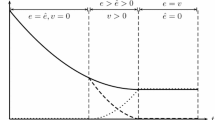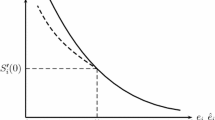Abstract
We propose enforcement strategies for emissions trading programs with bankable emissions permits that guarantee complete compliance with minimal enforcement costs. Our strategies emphasize imperfect monitoring supported by a high unit penalty for reporting violations, and tying this penalty directly to equilibrium permit prices. This approach is quite different from several existing enforcement strategies that emphasize high unit penalties for emissions in excess of permit holdings. Our analysis suggests that a high penalty for excess emissions cannot be used to conserve monitoring effort, and that it may actually increase the amount of monitoring necessary to maintain compliance.
Similar content being viewed by others
References
S. Barrett (2003) Environment and Statecraft Oxford University Press New York, NY
C. Boemare P. Quirion (2002) ArticleTitle“Implementing Greenhouse Gas Trading in Europe: Lessons from Economic Theory and International Experiences” Ecological Economics 43 213–230 Occurrence Handle10.1016/S0921-8009(02)00213-6
M. Cronshaw J. B. Kruse (1996) ArticleTitle“Regulated Firms in Pollution Permit Markets With Banking” Journal of Regulatory Economics 9 179–189 Occurrence Handle10.1007/BF00240369
C. A. Chavez J. K. Stranlund (2003) ArticleTitle“Enforcing Transferable Permit Systems in the Presence of Market Power” Environmental and Resource Economics 25 IssueID1 65–78 Occurrence Handle10.1023/A:1023646414602
Ellerman, A. D., and J-P Montero. 2002. “The Temporal Efficiency of SO2 Emissions Trading.” MIT Center for Energy and Environmental Policy Research Working Paper No. 02–003.
J. Harford (1987) ArticleTitle“Self-Reporting of Pollution and the Firm’s Behavior under Imperfectly Enforceable Regulations” Journal of Environmental Economics and Management 14 293–303 Occurrence Handle10.1016/0095-0696(87)90022-2
R. Innes (1999) ArticleTitle“Remediation and Self-Reporting in Optimal Law nforcement” Journal of Public Economics 72 379–393 Occurrence Handle10.1016/S0047-2727(98)00101-7
R. Innes (2000) ArticleTitle“Self-Reporting in Optimal Law Enforcement When Violators Have Heterogeneous Probabilities of Apprehension” Journal of Legal Studies 29 287–300 Occurrence Handle10.1086/468071
R. Innes (2001) ArticleTitle“Violator Avoidance Activities and Self-Reporting in Optimal Law Enforcement” Journal of Law, Economics, and Organization 17 IssueID1 239–256
R. Innes (2003) ArticleTitle“Stochastic Pollution, Costly Sanctions, and Optimality of Emission Permit Banking” Journal of Environmental Economics and Management 45 IssueID3 546–568 Occurrence Handle10.1016/S0095-0696(02)00021-9
L. Kaplow S. Shavell (1994) ArticleTitle“Optimal Law Enforcement with Self-Reporting of Behavior” Journal of Political Economy 103 IssueID3 583–606 Occurrence Handle10.1086/261947
A. Keeler (1991) ArticleTitle“Noncompliant Firms in Transferable Discharge Permit Markets: Some Extensions” Journal of Environmental Economics and Management 21 180–189 Occurrence Handle10.1016/0095-0696(91)90041-G
C. Kling J. Rubin (1997) ArticleTitle“Bankable Permits For the Control of Environmental Pollution” Journal of Public Economics 64 101–115 Occurrence Handle10.1016/S0047-2727(96)01600-3
P. Leiby J. Rubin (2001) ArticleTitle“Bankable Permits for the Control of Stock and Flow Pollutants: Optimal Intertemporal Greenhouse Gas Emission Trading” Environmental and Resource Economics 19 229–256 Occurrence Handle10.1023/A:1011124215404
J. Livernois C. J. McKenna (1999) ArticleTitle“Truth or Consequences: Enforcing Pollution Standards with Self-Reporting” Journal of Public Economics 73 IssueID3 415–440 Occurrence Handle10.1016/S0047-2727(98)00082-6
A. Malik (1990) ArticleTitle“Markets for Pollution Control when Firms are Noncompliant” Journal of Environmental Economics and Management 18 97–106 Occurrence Handle10.1016/0095-0696(90)90041-V
A. Malik (1992) ArticleTitle“Enforcement Costs and the Choice of Policy Instruments for Pollution Control” Economic Inquiry 30 714–721
A. Malik (1993) ArticleTitle“Self-Reporting and the Design of Policies for Regulating Stochastic Pollution” Journal of Environmental Economics and Management 24 241–257 Occurrence Handle10.1006/jeem.1993.1016
M. Palacios C. Chavez (2005) ArticleTitle“Determinants of Compliance in the Emissions Compensation Program, Santiago, Chile” Forthcoming in Environment and Development Economics 10 IssueID4 453–483 Occurrence Handle10.1017/S1355770X05002299
M. Palacios C. Chavez (2002) ArticleTitle“Programa de Compensación de Emisiones: Evaluación del Diseño de Fiscalización y su Cumplimiento” Estudios Públicos 88(Primavera) 97–126
D. J. Phaneuf T. Requate (2002) ArticleTitle“Incentives for Investment in Advanced Pollution Abatement Technology in Emission Permit Markets with Banking” Environmental and Resource 22 369–390 Occurrence Handle10.1023/A:1016097000190
M. J. Roberts A. M. Spence (1976) ArticleTitle“Effluent Charges and Licenses Under Uncertainty” Journal of Public Economics 5 193–208 Occurrence Handle10.1016/0047-2727(76)90014-1
J. Rubin (1996) ArticleTitle“A Model of Intertemporal Emissions Trading, Banking, and Borrowing” Journal of Environmental Economics and Management 31 269–286 Occurrence Handle10.1006/jeem.1996.0044
S. Schennach (2000) ArticleTitle“The Economics of Pollution Permit Banking in the Context of Title IV of the 1990 Clean Air Act Amendments” Journal of Environmental Economics and Management 40 IssueID3 189–210 Occurrence Handle10.1006/jeem.1999.1122
J. K. Stranlund C. A. Chavez B. Field (2002) ArticleTitle“Enforcing Emissions Trading Programs: Theory, Practice and Performance” Policy Studies Journal 30 IssueID3 343–361 Occurrence Handle10.1111/j.1541-0072.2002.tb02151.x
J. K. Stranlund C. Chavez (2000) ArticleTitle“Effective Enforcement of a Transferable Emissions Permit System with a Self-Reporting Requirement” Journal of Regulatory Economics 18 IssueID2 113–131 Occurrence Handle10.1023/A:1008160317757
J. K. Stranlund K. K. Dhanda (1999) ArticleTitle“Endogenous Monitoring and Enforcement of a Transferable Emissions Permit System” Journal of Environmental Economics and Management 38 IssueID3 267–282 Occurrence Handle10.1006/jeem.1999.1092
B. Swift (2001) ArticleTitle“How Environmental Laws Work: An Analysis of the Utility Sector’s Response to Regulation of Nitrogen Oxides and Sulfur Dioxide Under the Clean Air Act” Tulane Environmental Law Journal 14 IssueID2 309–423
InstitutionalAuthorNameU.S. Environmental Protection Agency (2000) Acid Rain Program 1999 Compliance Report U.S. EPA Acid Rain Program Washington, DC
InstitutionalAuthorNameU.S. Environmental Protection Agency (2003a) Acid Rain Program 2002 Compliance Report U.S. EPA Acid Rain Program Washington, DC
InstitutionalAuthorNameU. S. Environmental Protection Agency (2003b) Tools of the Trade: A Guide to Designing and Operating a Cap and Trade Program for Pollution Control U.S. EPA Office of Air and Radiation Washington, DC
InstitutionalAuthorNameU. S. Environmental Protection Agency (2003c) Section-by-Section Summary of the Clear Skies Act of 2003 U.S. EPA Office of Air and Radiation Washington, DC
U. S. Environmental Protection Agency. 2004. NO X Budget Trading Program: 2003 Progress and Compliance Report. Washington DC: U.S. EPA Office of Air and Radiation, Clean Air Market Programs. Available at http://www.epa.gov/airmarkets/fednox/index.html.
U. S. General Accounting Office. 2001. “EPA Should Improve Oversight of Emissions Reporting by Large Facilities.” GAO-01–46.
H. Egteren Particlevan M. Weber (1996) ArticleTitle“Marketable Permits, Market Power, and Cheating” Journal of Environmental Economics and Management 30 161–173 Occurrence Handle10.1006/jeem.1996.0011
A. J. Yates M. B. Cronshaw (2001) ArticleTitle“Pollution Permit Markets with Intertemporal Trading and Asymmetric Information” Journal of Environmental Economics and Management 42 104–118 Occurrence Handle10.1006/jeem.2000.1153
Author information
Authors and Affiliations
Corresponding author
Additional information
The authors are grateful to Anthony Heyes and three anonymous referees for their valuable comments. Partial support for this research was provided by the Cooperative State Research Extension, Education Service, U. S. Department of Agriculture, Massachusetts Agricultural Experiment Station under Project No. MAS00871.
Rights and permissions
About this article
Cite this article
Stranlund, J.K., Costello, C. & Chávez, C.A. Enforcing Emissions Trading when Emissions Permits are Bankable. J Regul Econ 28, 181–204 (2005). https://doi.org/10.1007/s11149-005-3108-6
Issue Date:
DOI: https://doi.org/10.1007/s11149-005-3108-6




